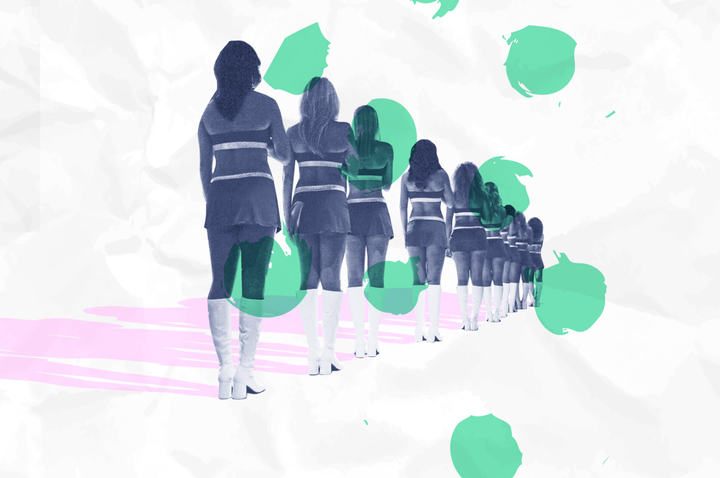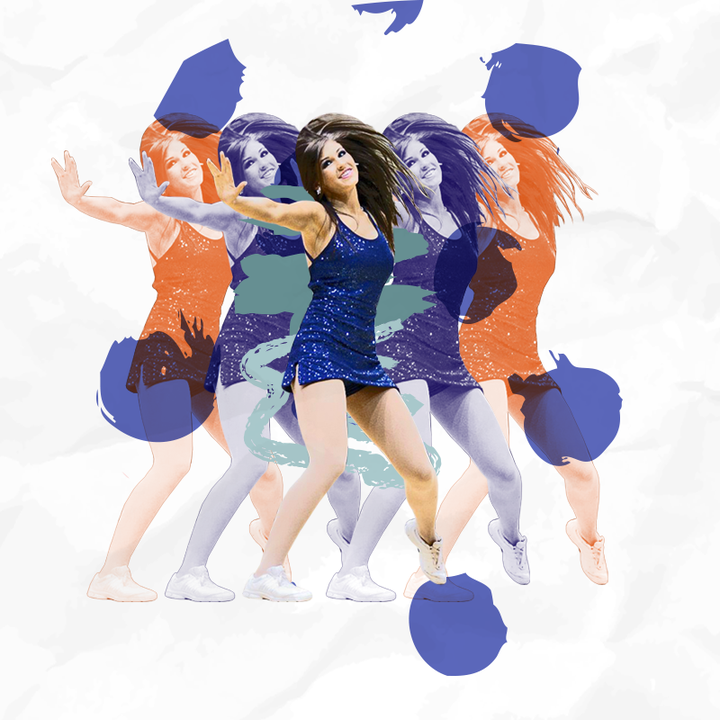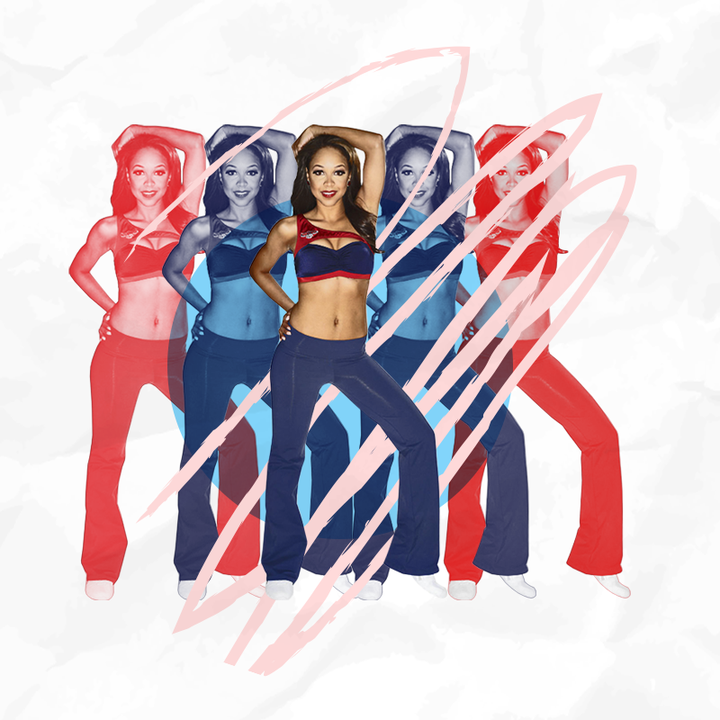
Of all the things that Lauren Herington remembers about her year as an NBA dancer, it’s the broom closet that rattles her most. “My coach would make me sit in there before games and think about if I was doing everything to be able to lose weight,” Lauren, a dancer for the Milwaukee Bucks from 2013 to 2014, recalls for Yahoo Lifestyle. “You know, basically like a child in time-out.”
When her coach thought she looked “questionable” weight-wise, Lauren says, she’d instruct the dancer to put on her spandex uniform in order to perform a “jiggle test” in front of the team. “She’d come up and grab underneath my butt or the side of my belly,” Lauren, then 18, remembers. “She’d be like, ‘Lose 5 pounds by tomorrow, and you’ll be fine.’”
While Lauren is opening up here for the first time about the full range of bullying she says she faced at the hands of her coach (the Bucks told Yahoo Lifestyle that they take all of the allegations “very seriously” but “have found no evidence to support these claims”), the Illinois native is no stranger to speaking out. In 2015, she brought a class-action lawsuit against the Milwaukee Bucks, alleging that the dancers — after covering costs of required beauty routines like spray tans and manicures — were effectively paid as little as $3-$4 an hour (according to interviews with her lawyers).
The Bucks, a team that brought in $87 million in revenue that year, “strongly denied” the claims but agreed to settle, paying a total of $250,000 in lost wages to roughly 40 dancers. Lauren spoke openly to the press at the time, explaining how the weight restrictions left her “dehydrating and starving” herself to fit into the uniform, and waitressing at Ruby Tuesday to pay the bills.
Her story — then and now — ran in stark contrast to the public images of NBA dancers, 20 or so per team, who seem to ooze effortless glamour and beauty. Elite athletes in their own right, they strut onto the court at halftime with the pluck and poise of a Broadway ensemble. They appear on Instagram, sparkling in sequins, and on Facebook, kicking in heels.
They’re fierce but polished, with near-constant smiles. But — much like the lawsuits filed by NFL cheerleaders in recent months — Lauren’s account suggests that the joyous vibe could be masking something darker. The NFL cheerleader lawsuits — which were preceded by multiple New York Times exposés on the topic — cite claims of unfair pay, gender discrimination and sexual harassment.
While it’s too soon to know the impact that those lawsuits will have on the NFL, their existence alone is monumental and signals a major cultural change. So too do many stories told to Yahoo Lifestyle, which conducted interviews with 15 women who have danced for the NBA, over years spanning 1997 to 2018.
What we found through these personal stories — in which young, ambitious talents described being mandated to lose weight, being paid less per game than the price of a single ticket, and generally being taken advantage of in a league worth hundreds of billions — was that Lauren’s claims weren’t the exception.
They were just the tip of the iceberg.

‘America’s sport’
To understand the stories of these women, it’s important to take a look at the sports behemoth that employs them. The National Basketball Association, which dates back to 1949, wields monumental power: With 450 players and 30 teams, each one of them — as of 2018 — worth over $1 billion, it’s one of the most lucrative sports empires of all time.
Thanks in part to superstars like LeBron James and Steph Curry, plus a forward-thinking stance on gender and race, the league has earned a cultlike following that grows each year. In 2017 alone, the league’s 1,200-plus games attracted more than a billion TV viewers, 21 million attendees and A-list celebrities in courtside seats nationwide. The fanbase has become so vast, in fact, that analysts have begun predicting that the NBA will soon eclipse the NFL’s fanbase, stealing the coveted moniker of “America’s sport.”
And the NBA dancers, whether most people realize it or not, play no small part in it all.
The squads’ arrival on courts in the late 1970s helped transform NBA games from mere sports events to “showtime,” a term coined by the Lakers owner who first introduced the idea of dancers, Jerry Buss. “My dad understood from the beginning that the key to make the Lakers appealing was equal parts sports and entertainment,” Buss’s daughter Jeanie wrote in her 2010 book, Laker Girl. “After 31 years, the party is still going on.”
If you’re an NBA dancer, though, that all depends on your perspective — which starts forming the moment an audition for a coveted spot on a squad begins.
While the details vary, the main ingredients seem to be the same: a multiday tryout complete with choreographed dance routines, in-person interviews and a fitness assessment, which is a vital component in the decision about whether a dancer will make the team. Hence the audition attire: form-fitting outfits that often verge on bikinis.
The audition scene — which can be glimpsed in pictures and videos dating back a decade and as recently as this year — is striking, with hundreds of women dancing in perfect unison while judges watch and take notes.
Those who make the team but don’t have the right “look” are informed immediately.

“The night I made the team, management pulled me aside to say they were concerned about my weight,” says Alanna Sarabia, who danced for the San Antonio Spurs from 2011 to 2012 (the year the Spurs decided to disband their dance squad, opting for a “family friendly” alternative). “We were given a bin of uniforms from the year before, and I might be a solid size 6, but the girl before you might be a 2 or a 4, and that’s your uniform now — so, good luck.”
Madison Murray, who danced with the Phoenix Suns from 2012 to 2015, shares a similar story. “Right after I made the team, they told me I had to lose 10 pounds,” she says. “I was probably softer than I should have been, but it still eats at you. I never felt good enough.”
Madison had been in Phoenix for only a short time at that point, after having booked a one-way flight from Salt Lake City, where she’d been a dancer for the Utah Jazz. There, she says, her weight had been a constant issue, and she was hoping to have a different experience on the Suns. Instead, she found that fixation on weight among NBA dance squads was the norm.
“It was my dream for 15 years, so I put it on a pedestal,” says Madison of being an NBA dancer. “I knew it would be a lot of hard work, and that never scared me, but I never knew how much of a toll it would take on my confidence. That was a really hard thing. Once you get in that position, you want to do everything you can to keep it. But it takes a toll … it was a rough life.”
‘I would say I definitely had an eating disorder’
Of course, not all of the women interviewed found the sit-down body assessment that marks the beginning of their time on the teams to be scarring.
“We did weigh-ins; the coach would sit us down and go over everything — from hair to makeup to body type, full-on top and bottom,” says Ana Ogbueze, a dancer for the Charlotte Hornets (formerly the Charlotte Bobcats) from 2004 to 2008. “Because often, the way you come in and audition is the way you have to stay.”
Ana, who had been inspired to try out because of her love for Paula Abdul (one of the original Laker Girls, brought in by Jerry Buss), was admittedly thrown off by the requirements — including mandatory food logs. “I was like, ‘Dang, I gotta write down everything I eat?’” she recalls. “I’d think, I don’t want to write this down because I don’t want them to think I’m eating poorly.” But Ana says her coach explained that it was simply to make her aware of what she was putting in her body, so that she could make improvements if needed. “I never felt the need to starve myself,” Ana says.
Many women said that the level of body shaming seems to hinge on the dance coach — which meant a handful were lucky to have loose weight regulations.
“I know that some of my peers had some diets but more for themselves; our coaches were supportive,” says Michelle Caputo, a dancer for the New York Knicks from 2005 to 2011, now the proprietor of a dance studio that acts as a feeder for the Knicks squad. A current dancer for the Detroit Pistons agrees with her: “My coach doesn’t put that type of pressure on us,” says the dancer, who spoke on the condition of anonymity. Chenise Johnson, a dancer for the Orlando Magic from 2017 to 2018, echoes the sentiment: “They say if you fluctuate between weights it’s completely fine. They just want to make sure you look your best.”
But those who never felt pressure to be thinner, or never witnessed it, were the outliers among those who spoke with Yahoo Lifestyle. The vast majority faced regular weigh-ins, body-fat assessments or both. Nine women spoke of a practice called “weight probation” or “weight warning,” in which dancers would be benched if they appeared to be a few pounds over their “goal weight.” This, in particular, prompted several dancers to resort to dangerous measures.

“We got weighed monthly; that’s what messed with me most,” says Sydney Sorenson, a dancer for the Utah Jazz from 2009 to 2012. “[So] the week of weigh-ins, I came up with all these methods to weigh in smaller, like not eat anything solid for a week. … One year they weighed us after Thanksgiving, and a girl had gained weight and couldn’t perform,” she recalls. “Point blank, I would say that I definitely had an eating disorder — especially the last year.” (Madison, from the Suns, says she also developed an eating disorder.)
“My teammates would regularly take laxatives before performances just to be able to eat regularly and still fit into this image,” a dancer from the L.A. Clippers from 2011 to 2012, who chose to remain anonymous because of her job, tells Yahoo Lifestyle. “I did it a few times because it was regular, which is really sad. But it seemed so normal.”
Kathryn Dunn, a Dallas Mavericks dancer from 2013 to 2016, recalls a particularly disturbing incident involving a rookie who “walked in on [another girl on the team] passed out in the bathroom … because she had been throwing up her food.”
‘Who’s deciding that women can’t be normal-sized and dance?’
Multiple women said the obsession with body image in the NBA motivated them to choose a career as a trainer or nutritionist, to work toward stopping the perpetuation of unhealthy body image. “One of my biggest goals is to empower women about their bodies,” says Chenelle Young, who danced for the Utah Jazz from 2010 to 2013 and has been directing the NBA’s international team (which travels to games in Europe) since. “I don’t think everyone thinks a tiny, 90-pound girl is sexy. … So I don’t understand why [the NBA] thinks everyone needs to be that.”
Lisa Murray, a dancer for the Golden State Warriors from 2010 to 2014 (who subsequently helped craft legislation in California that guarantees dancers minimum wage), finds the focus on image “upsetting” and outdated. “Why is it that when jumping from the collegiate world to the professional dance space we have to wear bathing suits and be subjected to ‘pageant-style’ auditions?” Lisa asks. “Who’s deciding that women can’t be normal-sized and dance? This product was created for a man, and it stayed present because men are in positions of power.”
Still, several women found the body restrictions to be par for the course in the dance world. “For me, it’s the nature of the game,” says Kierra Douglas, a dancer for the Atlanta Hawks from 2011 to 2012. “You know, you’re in a two-piece in front of thousands of fans and you are the face — in a sense — of the organization. You represent them and the brand; of course you want to look your best.”
Of the 14 teams that Yahoo Lifestyle reached out to, 13 declined the opportunity to comment on the strict body limitations discussed by dancers.
A spokesperson for the Dallas Mavericks (where an internal investigation in September exposed sexual harassment “spanning almost 20 years”) took the opportunity, telling Yahoo Lifestyle that “several years ago,” the team eliminated “outdated image industry practices” regarding weight. “A previous version of our contract contained a single clause that mentioned a weight policy. This policy provided that dancers were to remain within five pounds of their determined performance weight,” the statement reads. “Image concepts like this were prevalent and previously accepted in the industry; however, not anymore at the Mavs.”
The statement goes on to explain that the team is looking to “set an example” by revamping its standards. “[That] policy is inconsistent with our core values, and we removed it from our agreements,” the statement reads. “If there was an industry ‘look’ in the past, we’ve changed [it] for the better. The look is now about diversity, the art of dancing, and the dancers’ skill and performance.”
‘The pay was gas money — if that’
If the body-shaming tactics allegedly employed by many NBA dance teams are troubling, the dancers’ stories suggest that the compensation is worse. Three women remembered getting paid $50 a game; one said she took home $65. Three others said they made just $25 a practice, and one said that she and her teammates weren’t paid for practice at all. To put all that in perspective, the average price of a single NBA ticket during the 2012-2013 season (the earliest year this salary was mentioned) was $50; the average price of a ticket during the 2018-2019 season is $78. The average NBA stadium seats 18,966.
On top of low pay, more than half of the women described either seeing or reading the following phrase in their contract: “It’s a part-time job with a full-time commitment.” While that concept might be normalized, what it describes, in certain cases, technically could have been illegal. According to the U.S. Department of Labor, employees are required to be paid at least minimum wage for “all hours worked,” which for professional dancers means even warm-ups, practices and performances at charity events. None of the 14 teams that Yahoo Lifestyle reached shared salary information, but multiple spokespeople affirmed that they — in the words of Bucks spokesman Barry Baum — “treat our employees respectfully and in compliance with the law.”
“When they say a full-time commitment with part-time pay, they mean it,” says Ana Ogbueze from the Hornets, who danced while balancing college courses. Stephanie Hettchen, a dancer with the Miami Heat from 2010 to 2014, didn’t consider this a problem. “It was pretty much in our contract that it was a part-time job with a full-time commitment. You knew going in this was your dream, and just because I’m getting this exposure … doesn’t [mean it comes] with the money,” she says. “It’s more of an opportunity to open doors — especially in Miami.”

Only one of the 15 women interviewed, Kierra Douglas (then engaged, and now married, to NFL player Harry Douglas), said the salary was sufficient to live on. Three openly laughed at the idea that they could survive on NBA pay alone, and two described it as “gas money.” Five said they justified the pay by considering the job — one that they’d spent decades (in many cases) training for and beat out hundreds to secure — a “hobby.” All but one held at least two jobs; most mentioned three.
There’s perhaps no one better suited to talk about the pay than Lauren Herington, the only dancer known to use a lawsuit to get more money from the NBA. But even that, a $250,000 settlement split among roughly 40 dancers, likely did little to offset the money they put into their work on the team.
According to the Milwaukee Bucks’ rule book, which Lauren shared with Yahoo Lifestyle, dancers “must conform to all image standards set by the coach.” This might mean, Lauren says, that a woman with short hair would be required to get extensions — and, according to the rule book, visit the “exclusive hair salon of MBD.” According to the Mane Society, a hairstylists’ hub, hair extensions can cost anywhere from $200 to $3,000.
“There was this girl I rode with to practice who had to [pay for] extensions, which were like $600, and there were times she was like, ‘I literally don’t have money to go to the grocery store,’” Lauren says. “They were required, and there was a couple times where she would have one or two left on her head, which was horrible, and we didn’t even mean to laugh, but she couldn’t afford to get new ones. … After the hours spent tanning, hair, and nails … [our wages] broke down to be about $3-$4 per hour.”
While the Bucks may be the only team to have been publicly taken to task over salary so far, it’s not the only team mentioned by dancers as effectively paying at or below minimum wage.
“Was it enough to make ends meet? Not even close,” says Madison Murray of her time on the Phoenix Suns. “That was one of the hardest parts. If girls were doing OK, it was because their parents were funding them. I was self-funding, so I had three jobs. I was getting up at 4 a.m. and working until 11:30 p.m.”
Chenise Johnson, who danced for the Orlando Magic last year, says that rookies start at $10 an hour, then get a $1 raise each year. (The Magic, as a reference point, made $211 million in revenue in 2018.) “If you go into expecting the glitz and the glamour and think, ‘I’m about to get paid,’ you are going to get disappointed,” says Chenise. “The girls that stick around only do it because they love it. The pay obviously isn’t much.”
Some of the more recent dancers, like Chenise, seem particularly willing to accept their low pay, despite the millions being grossed by the NBA while they represent these teams. A current dancer for the Detroit Pistons, speaking on condition of anonymity, seemed pleased by the salary — despite mentioning that she had to find another, full-time job upon making the team.
“We actually get paid pretty good, in my opinion — $15 an hour,” says the dancer. “I think it’s [enough], because we’re not just doing it for the money. We’re doing it for the experience, for the exposure, to possibly branch off and do different things.” (The Pistons, currently valued at over $1.1 billion, brought in $221 million in revenue last year.)

On top of what dancers said were troublingly low salaries, three described a rule book that mandated they perform for free at charity events throughout the year. One of them was Kathryn Dunn, from the Dallas Mavericks.
In response, the Mavericks sent a statement to Yahoo Lifestyle refuting the idea that performing for free was mandatory but conceding that dancers were sometimes unpaid. “Dancers are now paid for all of the time that they work,” the statement read. “Previously, dancers may not have received compensation for voluntary game appearances or rehearsals, but today we pay our dancers for all mandatory rehearsals, preparation time and getting dressed for each assigned appearance, game appearances, non-game appearances (including charitable events), approved interviews and certain travel outside of the Dallas-Fort Worth metroplex. Also, the dancers are offered free food before the game.”
None of the 14 teams we reached out to refuted the dancers’ salary claims; many offered some version of a statement that described the payment structure as legal. (Read the full statements from the teams here.)
NBA corporate declined to comment on wages specifically but sent the following statement on behalf of NBA spokesman Mike Bass: “Team dancers are valued members of the NBA family. We work with our teams to ensure that they comply with applicable wage and working condition laws for all employees, and they’re provided safe, respectful and welcoming workplaces.”
‘You’re brainwashed to think you’ve reached the pinnacle of success’
So why did women choose to stay and not fight to change the working conditions? The truth is, it’s more complicated than it seems, and it has roots in something called “occupational segregation,” according to Yasemin Besen-Cassino, author of The Cost of Being a Girl: Working Teens and the Origins of the Gender Wage Gap — startlingly evident when comparing the incomes of male NBA players, “a masculine coded occupation,” and female NBA dancers, “a feminine occupation,” she explains.
“When an occupation is a feminine coded job, it pays less, and this type of gendered occupation is one of the most important contributors of the pay gap,” Besen-Cassino tells Yahoo Lifestyle. “In terms of why women accept low-pay jobs, it’s important to acknowledge that, for a long time, we shifted the burden of this persistent problem to the victims themselves.” Further, she says, “Previous research finds that when women negotiate, they might not succeed, and then experience a decline in their evaluations: They are less likely to be seen as team players, nice or caring for their craft. Such bias usually makes it less likely to ask for more.”
Many of the dancers talked about dreaming of this job for decades and training for it from as early as age 5. Nearly all of them discussed out-dancing hundreds of women (or more) at auditions and knowing that the number of dancers vying for the job could be used against them.
More than one woman mentioned feeling duped, saying that coaches persuaded the dancers to accept poor conditions under the pretense that they were lucky to be there. “It all starts from when you’re a little girl. You really want to be a dancer and be this successful woman, but when you finally get it, you find out that you are easily replaceable,” says Kathryn Dunn, the Dallas Mavericks dancer. “They ask you to do free appearances and pay you $15 for practices, but they back it up with, ‘If you don’t want to do it, we have hundreds of girls that would take your place.’ … These girls stick around because they think, ‘If I don’t dance, what am I going to do?’ You’re brainwashed to think you’ve reached the pinnacle of success.”
Kathryn wasn’t the only one to equate the NBA’s tactics to manipulation.
“It basically felt like they owned us,” says Sydney Sorenson, the Utah Jazz dancer, who claims that she was forced off the team because she spent too much time at other auditions. “I filed for unemployment because I was supposed to finish out the season and I needed the money to make it through school. I was totally OK with being done with the whole thing because I needed to repair a lot of things — I needed to repair my body, and I was in such a weird place. This was my identity, so I kind of crashed and burned, and I needed to rebuild — which sounds silly, but it had a huge effect on me.”
Nearly every dancer — whether happy about her time on the team or not — raved about the friendships she had made. “I still keep up with a lot of the girls … I was in a few of their weddings,” says Alanna Sarabia, who danced for the San Antonio Spurs. “Those will be the best memories of my life,” says Stephanie Hettchen, who danced for the Miami Heat. “One girl was a bridesmaid at my wedding,” adds Kierra Douglas, a dancer for the Atlanta Hawks. “It’s like a sisterhood, a sorority. You build friendships that last forever.”

Lisa Murray, who danced for the Golden State Warriors, finds statements like these irrelevant. “It’s wonderful people have found lasting relationships, but that shouldn’t negate the fact that women should be paid a living wage,” she says. “This is a perfect example of how women undermine their value in the workplace. If it really was a sisterhood, we wouldn’t be turning our back on women who have stood up and spoken out on being body-shamed, discriminated against, or paid unfairly. … Women are brainwashed into thinking this [culture] is appropriate. It’s infuriating.”
For Lauren Herington, who gave up dancing entirely, it’s not difficult to understand why women stay. “It’s kind of like a domestic abusive relationship — you’re kind of embarrassed about it,” she says. “You don’t really want to speak out about it, and you also sort of think it’s a normal situation.”
Are there dancers who will disagree that things need to change? Sure. But those voices, in an age like this one, are likely to soon be drowned out by the louder ones — of people like Lisa Murray, who are fed up with the way things are and unwilling to quiet down until they change.
“You are paid as a low-skilled worker but perform high-status work,” says Lisa. “When have ambassadors of an organization ever been paid as minimum-wage workers?” She hopes that the dancers will one day form a union, allowing them to fight for the rights they deserve. In the wake of multiple lawsuits from NFL cheerleaders this year, it’s not difficult to imagine that change is on the horizon. “Things could be better, that’s for sure,” concludes Chenelle Young, who danced for the Utah Jazz. “It’s 2018 — it’s time we brought them to light.”
More from Yahoo Lifestyle:
• School community demands that cheerleaders in ‘bigoted and hateful’ video apologize: ‘Racism is alive and well’
• Steph Curry pens powerful op-ed about his daughters: ‘There are no boundaries that can be placed on their futures’
• High school assistant principal suspended after comparing cheerleaders to strippers — and some say it was ‘racist’
